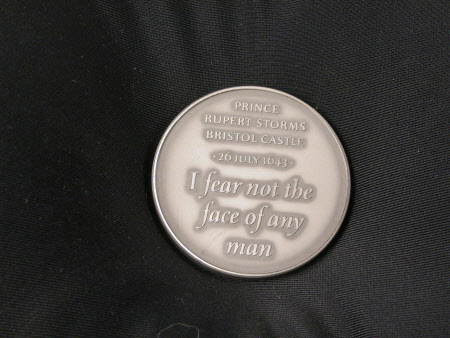Prince Rupert Storms Bristol Castle
Avril Vaughan (1937-2006)
Category
Coins and medals
Date
1992
Materials
Silver
Measurements
517 mm (Diameter)
Place of origin
United Kingdom
Order this imageCollection
Osterley Park and House, London
NT 773250
Summary
Silver, Prince Rupert Storms Bristol Castle, a medal designed by Avril Vaughan (1937-2006) and Michael Harvey (1931-2013), struck by Royal Mint, Llantrisant, 1992. A silver medal commemorating the storming of Bristol Castle by Prince Rupert of the Rhine (1619-1682), on 26 July 1643. The third medal in a set of twelve issued by the Royal Mint in 1992 and 1993, to mark the 350th Anniversary of the English Civil War. The obverse, designed by Avril Vaughan, shows Prince Rupert mounted in the foreground, his troops below. Rupert is carrying his white hunting poodle, Boy. In the background at right, the castle at Bristol. Artist’s monogram 'AV' near rim at lower right. The legend on the reverse, designed by Michael Harvey (1931-2013), reads 'PRINCE RUPERT STORMS BRISTOL CASTLE. / 26 JULY 1643. / I fear not the face of any man'. The latter phrase refers to a pamphlet written by Prince Rupert in which he defended his suitability to lead the Royalist forces on to London after the Battle of Edgehill.
Full description
The Civil War was fought, mainly in England, between 1642 and 1649, the result of a long struggle for power between King Charles I (1600-49) and Parliament. Prince Rupert of the Rhine, Duke of Cumberland (1619-1682) was the German-born younger son of King Charles I’s sister Elizabeth of Bohemia and her husband Frederick V, Elector Palatine. A highly talented individual, who later became a scientist and an amateur artist, Rupert is remembered today as the young man who became the epitome of the dashing Cavalier. Appointed commander of the Royalist cavalry at the age of just 23, he later became general of the King’s forces. Rupert played an important role at the Battle of Edgehill, where his drive and his bravery were seen at their best, but alongside his less positive qualities, impetuosity and an inability to win the confidence of the other Royalist leaders. Rupert captured the strategically important city of Bristol with his brother Maurice in July 1643. He hoped to take the Royalist forces on to London, but fears that he would plunder the city and allow atrocities to be committed on the population persuaded the King to prevent him from doing so. Deeply stung, Rupert published a ‘Declaration’ in the form of a pamphlet, in which he indignantly repudiated the accusations made against him: ‘I think there is none that take me for a coward,—for sure I fear not the face of any man alive,—yet I shall repute it the greatest victory in the world to see His Majesty enter London in peace without shedding one drop of blood.’ Rupert is shown in the medal carrying his white hunting poodle, Boy, which he did indeed take into battle with him, and which was killed at the Battle of Marston Moor in July 1644. Parliamentary propaganda put it about that the dog was a ‘dog-witch’ possessing satanic powers. This was the third in a series of twelve medals issued by the Royal Mint at monthly intervals from June 1992, to celebrate the 350th anniversary of the outbreak of the English Civil War. The twelve medals illustrate the significant points in the conflict, from the raising of Charles I’s standard at Nottingham on 22 August 1642, to his execution on 30 January 1649. The designs of the obverses of the medals were commissioned from three leading contemporary artists, John Lobban, Michael Rizzello and Avril Vaughan, whilst the reverses, each of which contains a quotation relating to the subject of the medal, were designed by the distinguished lettering artist Michael Harvey, best-known for the names of celebrated Renaissance artists carved into the stonework of the Sainsbury Wing of the National Gallery. Michael Harvey’s original artwork for the series is in the Library of the University of Reading (URL MS 5115, file 392). The selection of the twelve episodes and the accompanying legend was devised by the historian of Tudor coinage Dr Christopher Challis. The medals were issued in silver and in bronze, in editions of 2,500 and 5,000, retailing at £84.50 or £49.50 per medal respectively. It was possible to buy the medals singly or as a set of twelve, the latter housed in an African walnut case. The whole series is in the collection at Osterley, but without the wooden case (NT 773248-773258, NT 773623). Jeremy Warren 2019
Provenance
Given to the National Trust in 1993 by George Child Villiers, 9th Earl of Jersey (1910-1998).
Marks and inscriptions
Obverse, rim, lower right: AV (Avril Vaughan monogram) Reverse, legend: PRINCE RUPERT STORMS BRISTOL CASTLE. / 26 JULY 1643. / I fear not the face of any man
Makers and roles
Avril Vaughan (1937-2006), designer Michael Harvey (1931-2013), designer The Royal Mint, manufacturer

